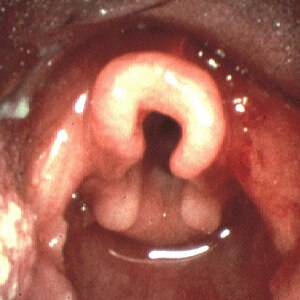Laryngomalacia
| Laryngomalacia | |
|---|---|
 |
|
| Omega shaped epiglottis, seen in laryngomalacia | |
| Classification and external resources | |
| Specialty | medical genetics |
| ICD-10 | Q31.5 |
| ICD-9-CM | 748.3 |
| OMIM | 150280 |
| DiseasesDB | 29421 |
| eMedicine | ped/1280 |
Laryngomalacia (literally, "soft larynx") is the most common cause of stridor in infancy, in which the soft, immature cartilage of the upper larynx collapses inward during inhalation, causing airway obstruction. It can also be seen in older patients, especially those with neuromuscular conditions resulting in weakness of the muscles of the throat. However, the infantile form is much more common. Laryngomalacia is one of the most common laryngeal congenital disease in infancy and public education about the signs and symptoms of the disease is lacking.
Although this is a congenital lesion, airway sounds typically begin at age 4–6 weeks. Until that age, inspiratory flow rates may not be high enough to generate the sounds. Symptoms typically peak at age 6–8 months and remit by age 2 years.
Late-onset laryngomalacia may be a distinct entity, which can present after age of 2 years
In infantile laryngomalacia, the supraglottic larynx (the part above the vocal cords) is tightly curled, with a short band holding the cartilage shield in the front (the epiglottis) tightly to the mobile cartilage in the back of the larynx (the arytenoids). These bands are known as the aryepiglottic folds. The shortened aryepiglottic folds cause the epiglottis to be curled on itself. This is the well known "omega shaped" epiglottis in laryngomalacia. Another common finding of laryngomalacia involves the posterior or back part of the larynx, where the arytenoid cartilages or the mucosa/tissue over the arytenoid cartilages can collapse into the airway and cause airway obstruction.
Laryngomalacia results in partial airway obstruction, most commonly causing a characteristic high-pitched squeaking noise on inhalation (inspiratory stridor). Some infants have feeding difficulties related to this problem. Rarely, children will have significant life-threatening airway obstruction. The vast majority, however, will only have stridor without other more serious symptoms such as dyspnea (difficulty breathing).
Although laryngomalacia is not associated with a specific gene, it is evidence that some cases may be inherited. Relaxation or a lack of muscle tone in the upper airway may be a factor. It is often worse when the infant is on his or her back, because the floppy tissues can fall over the airway opening more easily in this position.
The physician will ask some questions about the baby’s health problems and may recommend a flexible laryngoscopy to further evaluate the infant's condition.
...
Wikipedia
